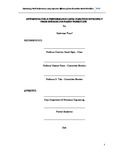| dc.contributor.author | Oyebimpe, Yusuf | |
| dc.date.accessioned | 2016-09-07T11:56:18Z | |
| dc.date.available | 2016-09-07T11:56:18Z | |
| dc.date.issued | 2010-12-12 | |
| dc.identifier.uri | http://repository.aust.edu.ng/xmlui/handle/123456789/476 | |
| dc.identifier.uri | http://library.aust.edu.ng:8080/xmlui/handle/123456789/476 | |
| dc.description.abstract | Waterflooding is one of the most common secondary recovery mechanisms available for improving oil recovery from known accumulations. Due to the limitation of available water for injection, there's a need to optimize the use of this limited resource. To this end, a methodology has been developed to allocate injection water to more efficient wells than to those of lower efficiency. Streamline simulation is a complementary tool to conventional finite difference simulation, provides a quick and efficient way for water re-allocation to optimize the waterflood. This tool has the ability to generate the contribution of a particular injector to offset producers. The producer-injector relationship yields what is termed Well allocation factors (WAF) to be used in computing injection efficiency.
This research seeks to optimize water allocation in an oilfield with the constraint of limited total volume of injection water. The proposed methodology is illustrated using a case study. Two reservoir models were built for 5-spot and 9-spot patterns to study maximization of oil recovery by optimizing water re-allocation during a waterflood. Injection wells were monitored until injection efficiency degraded to 60%; indicating unbalanced injection program. Water-reallocation program was initiated at this point using 6 months, 12 months and 18 months re-allocation cycles. The performance of the
waterflood was monitored for a period of 5years.
Results show marked decrease in water-cut between unoptimised and optimised floods. No significant difference in flood performance was observed for the various re-allocation cycles. This may be due to the degree of heterogeneity in the model and /or the assumption of no workovers of injector and producer wells allowed during the 5-year flood re-allocation period. It is concluded that the proposed methodology can be applied to determine the optimum reallocation frequency to maximize oil recovery from the flood. | en_US |
| dc.description.sponsorship | AUST | en_US |
| dc.language.iso | en | en_US |
| dc.subject | Oyebimpe Yusuf | en_US |
| dc.subject | Prof. David Ogbe | en_US |
| dc.subject | Streamline-Based Workflow | en_US |
| dc.subject | Ioptimizing Field Performance | en_US |
| dc.subject | Injection Efficiency | en_US |
| dc.subject | 2010 Petroleum Engineering Theses | en_US |
| dc.title | Ioptimizing Field Performance using Injection Efficiency from Streamline-Based Workflow | en_US |
| dc.type | Thesis | en_US |

